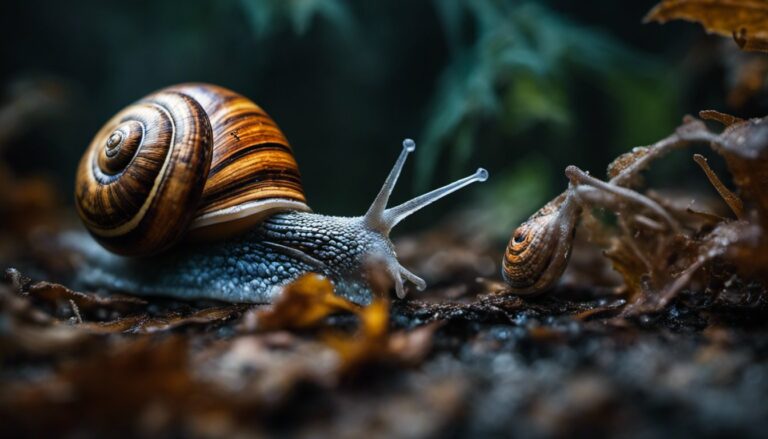Can Nerite Snails Live in Saltwater: A Comprehensive Guide for Aquarists
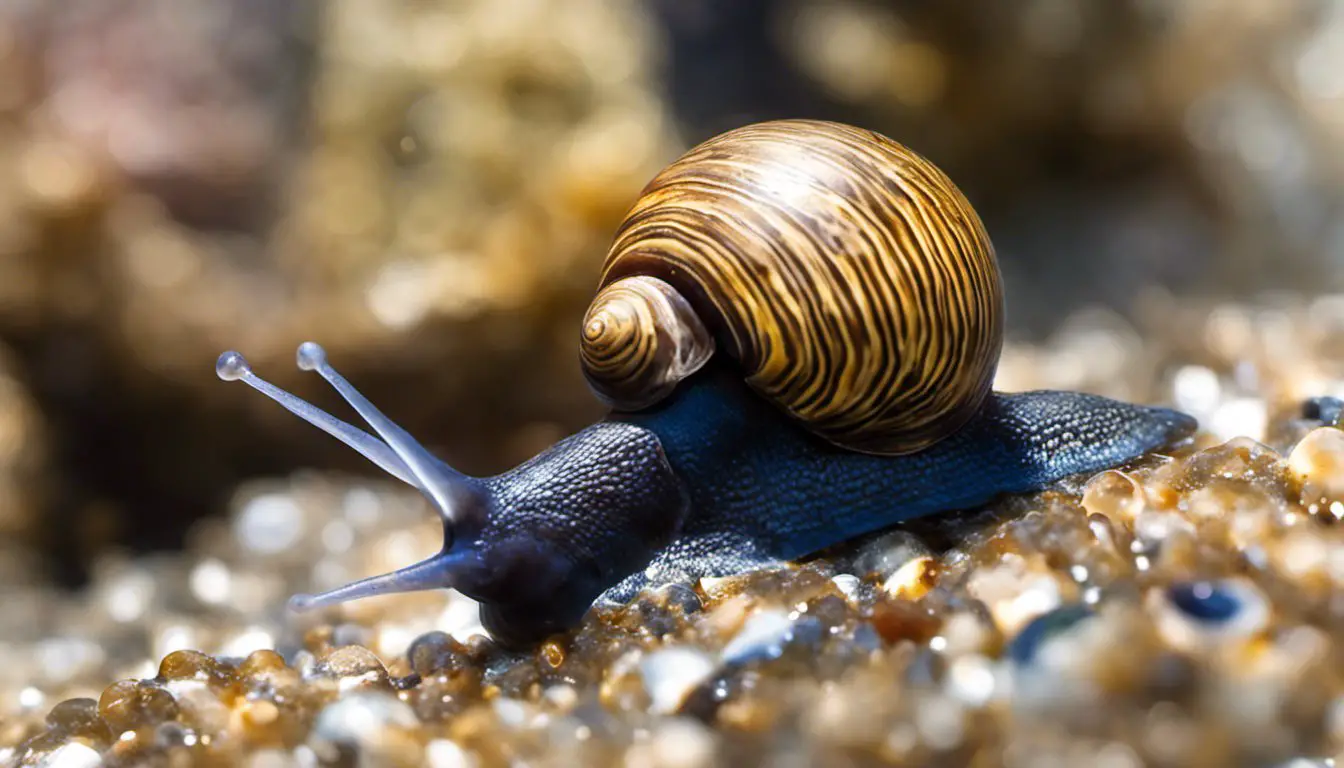
Nerite snails, a species belonging to the Neritidae family, are tiny yet fascinating creatures that can thrive in fresh and saltwater environments. Known for their small size, typically less than 1 inch long, these snails are critical in keeping your aquarium clean as they consume algae and other debris, making them a beneficial addition to any aquatic habitat.
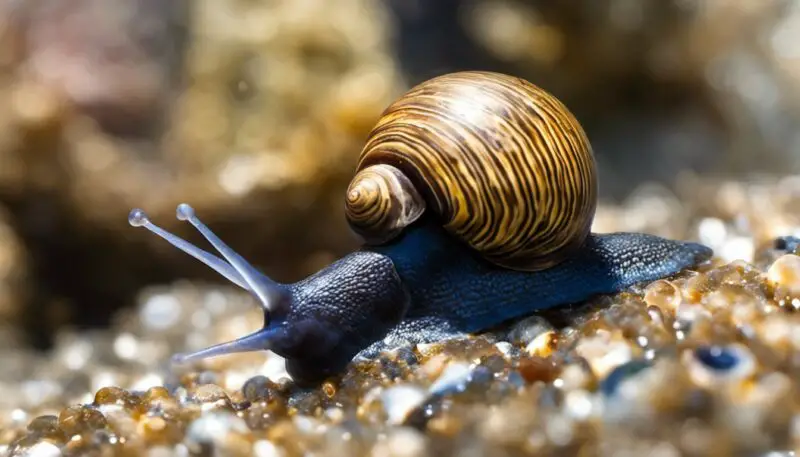
Can nerite snails live in saltwater? Yes, they can! In the realm of saltwater aquariums, many aquarists consider nerite snails to be essential in maintaining a healthy and balanced ecosystem. Their unique rounded shells make them easily navigate the tank without disrupting the arrangement of rocks or corals. As they come from tidal areas in the Pacific and Caribbean Oceans, nerite snails have adapted well to saltwater environments and can significantly contribute to the overall health of your marine aquarium.
Selecting the right species of nerite snails for your saltwater tank ensures their well-being and effectiveness in their cleaning duties. By understanding their specific needs, behavior, and compatibility, you can confidently introduce nerite snails to your aquarium, allowing them to flourish and benefit the aquatic environment.
Contents
Table of Contents
Understanding Nerite Snails

Nerite snails are a fascinating addition to any saltwater aquarium. They belong to the Neritidae family and include a variety of genera such as Nerita, Theodoxus, and others. You’ll appreciate their unique characteristics and benefits as a saltwater aquarium enthusiast.
Saltwater nerite snails, like their marine counterparts (Nerita genus), are known for their stunning shells in various patterns and colors. These snails are visually appealing and recognized as efficient algae eaters, helping keep your aquarium ecosystem clean and healthy.
When keeping nerite snails in your saltwater tank, one important factor is the water hardness (GH). The preferable GH level for saltwater nerites typically ranges from 8.1 to 8.4. Maintaining proper water hardness ensures their shells’ healthy growth and development, ultimately contributing to their overall well-being.
In addition to GH, the water temperature in your saltwater tank should be between 72-78 degrees Fahrenheit. A stable temperature allows nerite snails to thrive in their environment and interact harmoniously with other fish and invertebrates.
While most nerites in the Neritidae family are known for their algae-eating abilities, a few species in the Theodoxus genus also adapt well to saltwater environments. Just like Nerita snails, these species help keep your tank clean and can add an interesting dynamic to your aquatic world.
Understanding the unique attributes of nerite snails, along with their proper aquarium setup and compatible tankmates, will ensure that your saltwater aquarium remains a vibrant and healthy ecosystem. Focusing on factors like GH, and temperature, and selecting suitable snail species is essential to creating an ideal home for these captivating creatures.
Different Species of Nerite Snails

Nerite snails comprise a diverse group that can be found in various regions, such as Africa and the Caribbean. Known for their unique appearances and usefulness in saltwater aquariums, these snails come in several types, each with its distinct characteristics.
Zebra nerite snails are instantly recognizable by their trademark black and yellow striped shells. Native to Africa, they are popular among aquarists due to their algae-eating habits, helping maintain a clean and healthy environment within the tank.
The horned nerite snail is an intriguing option for those seeking a more peculiar-looking snail. Boasting a distinctive spiral shell adorned with multiple “horns,” they are the perfect addition to add visual interest to your saltwater aquarium.
Another eye-catching species is the tiger nerite snail. They display a beautiful pattern reminiscent of a tiger’s coat, making them popular for aquarists who value aesthetics. Like most nerite snails, they are excellent algae eaters and contribute to a healthy tank environment.
On the other hand, the red racer nerite snail sports a striking red and black pattern on its shell. This species can be found in the Caribbean and is particularly well-suited for reef aquariums, as they blend in seamlessly with their surroundings.
Black racer nerite snails are known for their sleek black shells. They provide a more subtle aesthetic option while still being adept at keeping your aquarium free of algae.
Lastly, the olive nerite snail has a smooth, olive-colored shell with a glossy appearance. Their less conspicuous looks make them ideal for aquarists who prefer a more understated appearance in their tank.
Each of these nerite snail species brings unique visual appeal to your saltwater aquarium and valuable algae-eating abilities. With such a diverse range of options, you can easily find the perfect nerite snail to suit your specific preferences and needs.
Ideal Habitat and Tank Conditions

When setting up an ideal habitat for your nerite snails in a saltwater tank, it’s essential to keep in mind the water conditions they thrive in. Both freshwater and saltwater nerite snails belong to the Neritidae family, with their habitat preferences varying slightly depending on their natural environment.
Creating the perfect saltwater tank for nerite snails begins with choosing an appropriate tank size. A minimum of 5 gallons should be provided to ensure they have ample space to move and find food. However, a larger tank will allow for more stability in water parameters and better accommodate tank mates.
Temperature plays a significant role in maintaining a healthy environment for your snails. Maintaining a consistent temperature of 72-78 degrees Fahrenheit is crucial to support their well-being and activity.
Substrate is another important aspect to take into account. Fine substrates, such as calcium substrates, are more beneficial for saltwater nerite snails, as they allow them to move easily and provide additional nutrition.
Water conditions also have a significant impact on snail health. Saltwater nerites require higher pH values ranging from 8.1 to 8.4. It’s also important to maintain stable water parameters and monitor water quality regularly to prevent any sudden changes that might result in snails becoming stressed or even perishing.
Saltwater tanks are typically more sensitive than freshwater tanks, with variable water conditions, so it’s important to be diligent about your tank setup when keeping nerite snails. Set up the tank with plenty of hiding spots and natural decorations, such as rocks or driftwood. This will create an environment that mimics their natural habitat and makes them feel safe and secure.
In summary, to create the ideal habitat and tank conditions for nerite snails in a saltwater aquarium, focus on providing an appropriate tank size, maintaining stable water conditions, choosing a suitable substrate, and keeping a consistent temperature throughout the tank. Doing so’ll provide a healthy environment for your snails to thrive and keep your aquarium clean and algae-free.
Dietary Requirements of Nerite Snails

As an aquarium enthusiast, it’s crucial to understand the dietary needs of your Nerite Snails. These saltwater snails are algae-eating creatures, so providing them with the right diet is essential for their health and well-being.
One of the key components of a Nerite Snail’s diet is algae. They thrive on various types of algae, making them an excellent addition to your saltwater tank to help control algae populations. You can find algae growing naturally in your aquarium, but you may also supplement their diet with purchased algae wafers. This ensures they always have access to the proper nutrition.
Another component to a healthy Nerite Snail’s diet is calcium. Calcium is vital for snails, promoting healthy shell growth and helps prevent shell erosion. You can find calcium in green, leafy vegetables such as spinach, which is also a great source of nutrition for your snails. To add spinach to your snail’s diet, simply blanch it for a few minutes to soften it up and place it in the aquarium for your snails to munch on.
In addition to algae and calcium-rich vegetables, Nerite Snails will also benefit from a more varied diet. Providing them with a mix of aquarium-safe vegetables and algae will keep them healthy and satisfied. These herbivorous creatures enjoy snacking on blanched zucchini, cucumber, and even small pieces of blanched broccoli.
To ensure your Nerite Snails maintain a healthy and balanced diet, remember to keep a steady supply of algae in the tank, supplement their diet with algae wafers and calcium-rich vegetables, and mix in other vegetable snacks for variety. By catering to their dietary needs, you will provide a thriving environment for your saltwater Nerite Snails while also keeping your aquarium clean and algae-free.
Breeding Nerite Snails
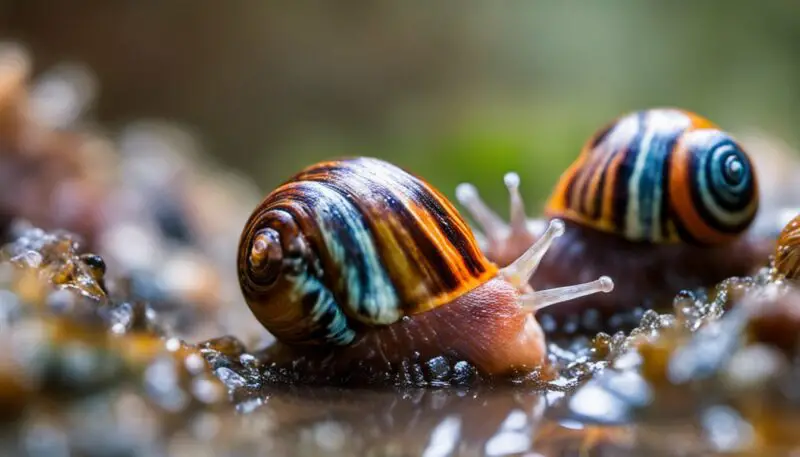
Breeding nerite snails can be a bit challenging because they require brackish water conditions to reproduce successfully. To facilitate the breeding process, you must maintain a salinity level of 1.005-1.010 in the water1. Here are some steps you can follow to create the ideal environment for nerite snail breeding:
- Choose the right substrate: Mix calcium sand with saltwater to provide a proper foundation for snail breeding1.
- Ensure optimal water conditions: In addition to adjusting the salinity, maintain the water temperature between 72-78°F and the pH level around 8.1-8.4.
- Provide adequate nutrition: A balanced diet will help enhance snails’ reproductive ability. Offer them a mix of algae wafers, blanched vegetables, and calcium supplements to ensure healthy breeding.
- Identify the gender of your nerite snails: Unfortunately, this can be difficult, as males and females look very similar 2. Having multiple snails in the tank is a good idea to increase the likelihood of having both sexes present.
- Watch for eggs: Once the snails mature, they may mate and lay eggs. Nerite snail eggs resemble tiny white capsules, usually attached to rocks or other surfaces in the tank.
- Monitor the tank regularly: Keep an eye on the water quality, temperature, and salinity, and stay on top of maintenance to ensure a healthy environment for your breeding snails.
It’s important to note that nerite snail breeding can be a meticulous process, and success is not always guaranteed. But with patience, effort, and careful attention to the snails’ needs, you can maximize their chances of breeding, potentially adding new life to your tank.
Breeding Nerite Snails: Watch this
Nerite Snails in Aquarium
Nerite snails are small, versatile invertebrates that are a popular addition to both freshwater and saltwater aquariums. They stand out not only for their charming appearance but also for their remarkable ability to keep the tank clean. Reaching a maximum size of about 1 inch in diameter, these tiny creatures are perfect for various tank sizes.
Regarding appearance, nerite snails typically have round-shaped shells with varying color patterns. Their eye-catching designs can serve as a natural decoration, adding to the overall aesthetics of your aquarium. Watch for the different color varieties to make your tank visually appealing.
In a saltwater setup, nerite snails are especially effective at removing algae from your tank. They will scour the tank’s surfaces, including the glass, filter, and live rock, consuming algae along their way. This cleaning activity helps maintain a healthy environment for all tank inhabitants and reduces the need for frequent tank maintenance on your part.
To ensure these diligent invertebrates thrive in your aquarium, it’s essential to provide adequate live rock and hiding spaces. Live rock offers natural grazing spots for algae and serves as a refuge for nerite snails when they feel threatened or need a place to rest. A diverse mix of live rock will encourage healthy snail populations and make your tank a more natural and robust ecosystem.
As for their lifespan, nerite snails can live approximately 1-2 years if provided with proper care and suitable water conditions. To maximize their life expectancy, it’s crucial to maintain stable water parameters and keep the tank temperature and salinity within the appropriate ranges. Also, ensure that no predators in the tank could harm your nerite snails.
In conclusion, incorporating nerite snails into your saltwater aquarium brings several benefits, such as improved cleaning and visual appeal. Understanding their size, appearance, and requirements allows you to create a thriving environment for these beneficial invertebrates and your other tank inhabitants.
Tank Companions for Nerite Snails

When setting up a saltwater aquarium, selecting the appropriate tank mates for your Nerite snails is crucial for creating a harmonious environment. These peaceful snails thrive when surrounded by other mild-mannered aquatic creatures, so choosing the right neighbors for them is essential.
One suitable option is to pair your Nerite snails with different types of shrimp, such as red cherry shrimp, ghost shrimp, or blue velvet shrimp. These invertebrates share a similar temperament and can coexist peacefully without causing any harm to one another.
Small and non-aggressive fish are also excellent tank companions for your Nerite snails. Species such as rasboras, neon tetras, and honey gourami are known to get along well with snails in an aquarium. Like the snails, these fish maintain a clean and balanced habitat.
While guppies and some cichlids can be suitable tank mates, monitoring their behavior is essential to ensure they don’t become a threat to your Nerite snails. Be cautious when introducing these fish into your snail’s home, and be prepared to separate them if any conflict arises.
On the other hand, it’s best to avoid housing aggressive or territorial fish like bettas, tiger barbs, and some species of cichlids with your Nerite snails. These fish are known to attack snails, putting your aquarium’s peaceful residents at risk.
In conclusion, it’s essential to carefully consider the different marine species that will share your saltwater aquarium with Nerite snails. Choosing non-aggressive, harmonious tank mates will provide the snails with a safe and tranquil environment, allowing them to thrive and contribute to the overall health of your aquatic habitat.
Common Health Concerns for Nerite Snails

As a nerite snail owner, you might encounter certain health concerns that your snails could face in their saltwater habitat. Knowing these issues can help you take preventive measures and address problems early on, ensuring your snails live a healthy and happy life.
One common health concern for nerite snails is edema, which is a swelling caused by excess fluid. To prevent edema, maintain a stable and clean environment in your tank, keeping a close eye on water parameters. Regular water changes can help in maintaining optimal water conditions.
Exposure to copper in your aquarium can be detrimental to nerite snails. Copper is toxic to most invertebrates, including nerite snails. Make sure to avoid using copper-based medications in your tank and double-check on the components of your aquarium equipment, as some may have traces of copper.
Toxins can also adversely affect your nerite snails. Test your water regularly to ensure no harmful substances are present. Avoid using aerosols, cleaning products, or other chemicals near your aquarium, as they may enter the water and harm your snails.
Monitoring ammonia, nitrite, and nitrate levels is crucial for your snails’ well-being. Elevated ammonia levels can cause irritation and stress for your snails, while high nitrite and nitrate levels can be lethal. Establishing a proper nitrogen cycle in your tank and conducting regular water tests can help you maintain a safe and healthy environment.
In addition to these preventive measures, remember to provide your nerite snails with a balanced diet, proper tank temperature, and good water quality to ensure their longevity. You can maintain a thriving aquatic environment for your nerite snails by staying informed and addressing any issues proactively.
Maintaining Your Aquarium With Nerite Snails
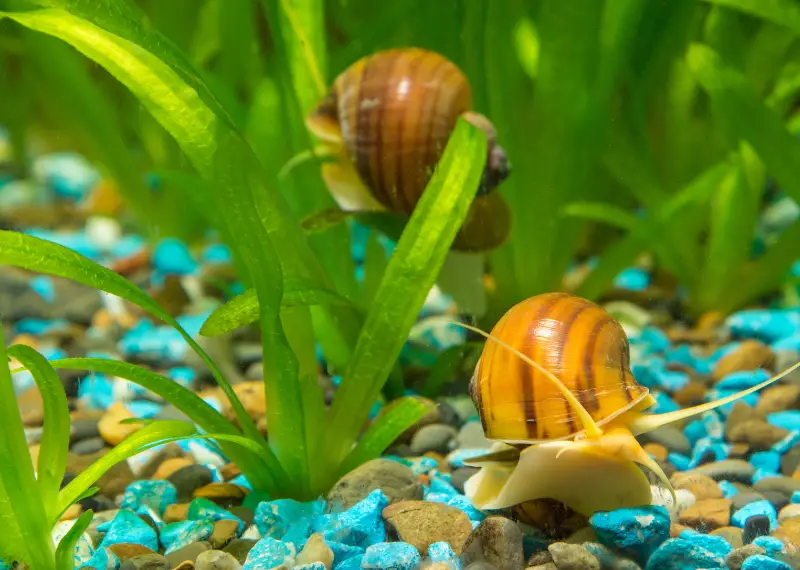
Nerite snails can be a fantastic addition to your saltwater aquarium, assisting in keeping it clean and healthy. They are well-known for their cleaning abilities and will tirelessly work on various surfaces, helping you maintain a beautiful and thriving aquatic environment.
To make the most of your nerite snails’ cleaning capabilities, be sure to provide them with surfaces they are particularly fond of. Such surfaces include glass, driftwood, plants, and rocks. Your snails will glide over these surfaces, consuming different types of algae and other undesirable substances.
In addition to general cleanup, nerite snails help address specific issues, such as black beard algae, cyanobacteria, and diatoms. Introducing these snails into your aquarium can significantly reduce the appearance of such growths and keep them under control, as they efficiently consume these organisms as a part of their natural diet.
When introducing nerite snails, it’s also essential to monitor your aquarium’s health. Regular testing will ensure that your water parameters are suitable for these snails and other inhabitants of the tank. Maintain your aquarium properly by performing regular water changes and providing the necessary nutrients and water conditions for your invertebrates and saltwater fish.
Nerite snails are not only excellent cleaners, but they also add visual interest to your aquarium. By incorporating these diligent workers into your saltwater aquarium, you can maintain a cleaner and healthier environment for all of your aquatic inhabitants. Moreover, their unique patterns and markings will surely bring a touch of beauty and intrigue to your tank.
Can Nerite Snails Live in Saltwater

In your journey to understand nerite snails, you have learned about their unique features and care requirements. These fascinating saltwater creatures are known for their distinctive gill and operculum. With proper care and knowledge, they can be a valuable addition to your aquarium setup, even for beginners.
Nerite snails, like the Neritina natalensis, are avid climbers and can be found scaling the walls of your tank. Their adaptability to various water conditions, especially in tropical setups, makes them easy to care for and maintain. To ensure your nerite snails remain in good health, it’s essential to familiarize yourself with their care requirements and observe their behavior regularly.
While nerite snails are relatively simple to care for, beginners should not take their responsibilities lightly. You should always follow proper care guidelines to maintain a healthy environment, provide adequate food, and ensure suitable water conditions. This way, you can ensure the well-being of your nerite snails and enjoy their algae-eating and cleaning capabilities.
To recap, nerite snails are unique saltwater invertebrates that can thrive in various aquatic environments, particularly tropical ones. Their distinctive features, such as the gill and operculum, make them an intriguing addition to your aquarium. With the right care and attention, beginners can successfully maintain these helpful, algae-eating climbers, making for a thriving and visually appealing underwater world.
Frequently Asked Questions
What types of Nerite snails are suitable for saltwater?
Several species of Nerite snails can thrive in saltwater environments. Some popular choices include the Zebra Nerite snail, Tiger Nerite snail, and the Olive Nerite snail. These snails are known for their stunning patterns, making them an attractive addition to any saltwater aquarium.
How to introduce Nerite snails to a saltwater tank?
When introducing Nerite snails to your saltwater tank, it’s essential to acclimate them slowly to the new environment. You can do this by floating the snail in the bag it came in at the top of your tank for 15-20 minutes to adjust to the water temperature.
Then, gradually add small amounts of your tank water to the bag over the next hour to ensure the snail adapts to the tank’s water parameters. Finally, gently release the Nerite snail into your tank, avoiding pouring any stored water into the aquarium.
What’s the ideal size of Nerite snails for saltwater aquariums?
Nerite snails can range in size from under an inch to over two inches. For most saltwater aquariums, a Nerite snail that is around one inch long is ideal. This will ensure the snail has enough room to move around and explore while still efficiently keeping your tank clean from algae.
At what temperature should saltwater Nerite snails be kept?
Saltwater Nerite snails prefer a water temperature of around 72-78 degrees Fahrenheit (22-26 degrees Celsius). Maintaining a stable temperature within this range is crucial to ensure your Nerite snails’ health and well-being.
Can Nerite snails breed in saltwater?
Nerite snails are unlikely to breed in saltwater environments. Their larvae require brackish water to develop and survive. Without this specific habitat, Nerite snails will lay eggs but not hatch in a saltwater aquarium.
Are Nerite snails compatible with reef tanks?
Nerite snails are compatible with most reef tank setups. They are peaceful in nature and can coexist with various fish and invertebrates. Additionally, they provide a valuable service to your tank by consuming algae and keeping the glass and live rock surfaces clean, which is beneficial for the overall health of your reef ecosystem.


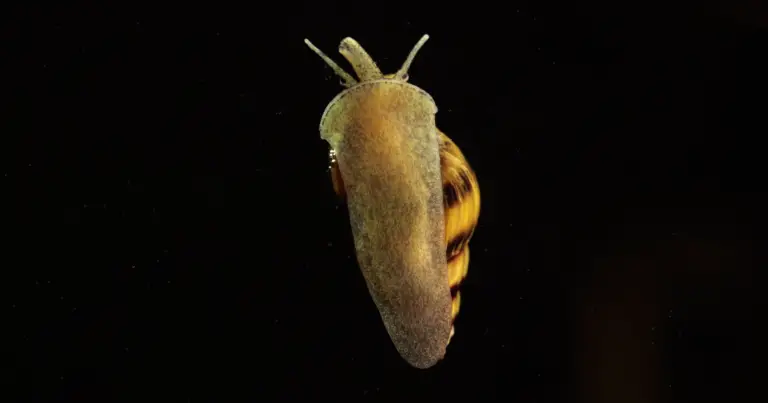
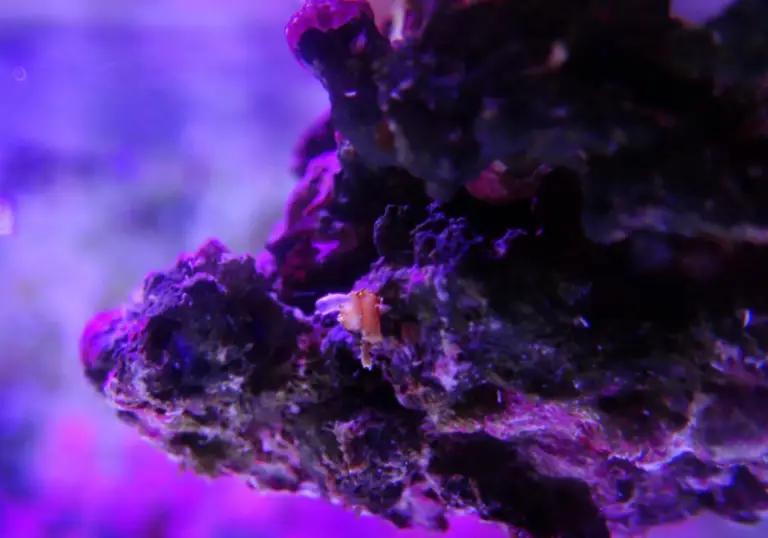

![What Do Apple Snails Eat? [Full Guide]](https://allourcreatures.com/wp-content/uploads/2021/10/what-do-apple-snails-eat-768x512.jpg)
